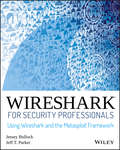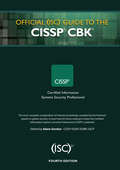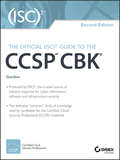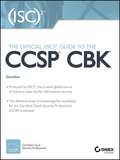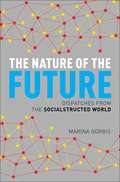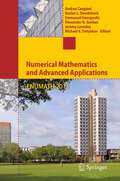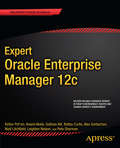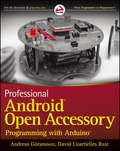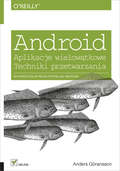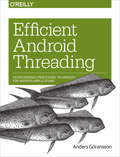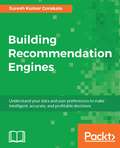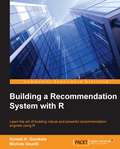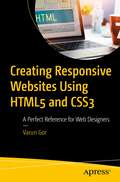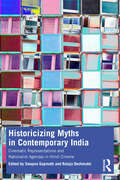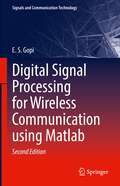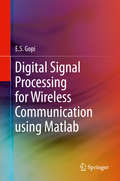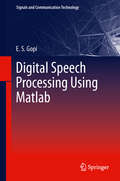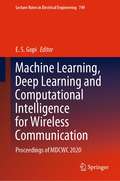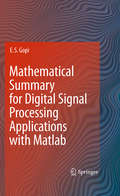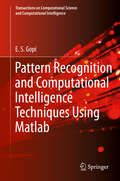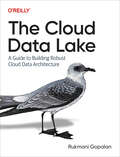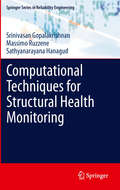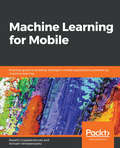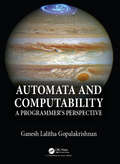- Table View
- List View
Wireshark for Security Professionals: Using Wireshark and the Metasploit Framework
by Adam Gordon Jessey BullockMaster Wireshark to solve real-world security problems If you don’t already use Wireshark for a wide range of information security tasks, you will after this book. Mature and powerful, Wireshark is commonly used to find root cause of challenging network issues. This book extends that power to information security professionals, complete with a downloadable, virtual lab environment. Wireshark for Security Professionals covers both offensive and defensive concepts that can be applied to essentially any InfoSec role. Whether into network security, malware analysis, intrusion detection, or penetration testing, this book demonstrates Wireshark through relevant and useful examples. Master Wireshark through both lab scenarios and exercises. Early in the book, a virtual lab environment is provided for the purpose of getting hands-on experience with Wireshark. Wireshark is combined with two popular platforms: Kali, the security-focused Linux distribution, and the Metasploit Framework, the open-source framework for security testing. Lab-based virtual systems generate network traffic for analysis, investigation and demonstration. In addition to following along with the labs you will be challenged with end-of-chapter exercises to expand on covered material. Lastly, this book explores Wireshark with Lua, the light-weight programming language. Lua allows you to extend and customize Wireshark’s features for your needs as a security professional. Lua source code is available both in the book and online. Lua code and lab source code are available online through GitHub, which the book also introduces. The book’s final two chapters greatly draw on Lua and TShark, the command-line interface of Wireshark. By the end of the book you will gain the following: Master the basics of Wireshark Explore the virtual w4sp-lab environment that mimics a real-world network Gain experience using the Debian-based Kali OS among other systems Understand the technical details behind network attacks Execute exploitation and grasp offensive and defensive activities, exploring them through Wireshark Employ Lua to extend Wireshark features and create useful scripts To sum up, the book content, labs and online material, coupled with many referenced sources of PCAP traces, together present a dynamic and robust manual for information security professionals seeking to leverage Wireshark.
Official: Guide to the CISSP CBK ((ISC)2 Press)
by Adam Gordon<p>As a result of a rigorous, methodical process that (ISC)² follows to routinely update its credential exams, it has announced that enhancements will be made to both the Certified Information Systems Security Professional (CISSP) credential, beginning April 15, 2015. (ISC)² conducts this process on a regular basis to ensure that the examinations and subsequent training and continuing professional education requirements encompass the topic areas relevant to the roles and responsibilities of today’s practicing information security professionals. <p>Refreshed technical content has been added to the official (ISC)² CISSP CBK to reflect the most current topics in the information security industry today. Some topics have been expanded (e.g., asset security, security assessment and testing), while other topics have been realigned under different domains. The result is an exam that most accurately reflects the technical and managerial competence required from an experienced information security professional to effectively design, engineer, implement and manage an organization’s information security program within an ever-changing security landscape.</p>
The Official (ISC)2 Guide to the CCSP CBK
by Adam GordonGlobally recognized and backed by the Cloud Security Alliance (CSA) and the (ISC)2 the CCSP credential is the ideal way to match marketability and credibility to your cloud security skill set. The Official (ISC)2 Guide to the CCSPSM CBK Second Edition is your ticket for expert insight through the 6 CCSP domains. You will find step-by-step guidance through real-life scenarios, illustrated examples, tables, best practices, and more. This Second Edition features clearer diagrams as well as refined explanations based on extensive expert feedback. Sample questions help you reinforce what you have learned and prepare smarter. Numerous illustrated examples and tables are included to demonstrate concepts, frameworks and real-life scenarios. The book offers step-by-step guidance through each of CCSP’s domains, including best practices and techniques used by the world's most experienced practitioners. Developed by (ISC)², endorsed by the Cloud Security Alliance® (CSA) and compiled and reviewed by cloud security experts across the world, this book brings together a global, thorough perspective. The Official (ISC)² Guide to the CCSP CBK should be utilized as your fundamental study tool in preparation for the CCSP exam and provides a comprehensive reference that will serve you for years to come.
The Official (ISC)2 Guide to the CCSP CBK
by GordonGlobally recognized and backed by the Cloud Security Alliance (CSA) and the (ISC)2 the CCSP credential is the ideal way to match marketability and credibility to your cloud security skill set. The" Official (ISC)2(R) Guide to the CCSPSM CBK(R) "is your ticket for expert insight through the 6 CCSP domains. You will find step-by-step guidance through real-life scenarios, illustrated examples, tables, best practices, and more. Sample questions help you reinforce what you have learned and prepare smarter. Easy-to-follow content guides you through - Major topics and subtopics within the 6 domains- Detailed description of exam format- Exam registration and administration policiesReviewed by cloud security experts, and developed by (ISC)2, this is your study guide to fully preparing for the CCSP and reaffirming your unique cloud security skills. Get ready for the next step in your career with "Official (ISC)2 Guide to the CCSP CBK". " "
The Nature of the Future: Dispatches from the Socialstructed World
by Marina GorbisA renowned futurist offers a vision of a reinvented world. Large corporations, big governments, and other centralized organizations have long determined and dominated the way we work, access healthcare, get an education, feed ourselves, and generally go about our lives. The economist Ronald Coase, in his famous 1937 paper "The Nature of the Firm," provided an economic explanation for this: Organizations lowered transaction costs, making the provision of goods and services cheap, efficient, and reliable. Today, this organizational advantage is rapidly disappearing. The Internet is lowering transaction costs--costs of connection, coordination, and trade--and pointing to a future that increasingly favors distributed sources and social solutions to some of our most immediate needs and our most intractable problems. As Silicon Valley thought-leader Marina Gorbis, head of the Institute for the Future, portrays, a thriving new relationship-driven or socialstructed economy is emerging in which individuals are harnessing the powers of new technologies to join together and provide an array of products and services. Examples of this changing economy range from BioCurious, a members-run and free-to-use bio lab, to the peer-to-peer lending platform Lending Club, to the remarkable Khan Academy, a free online-teaching service. These engaged and innovative pioneers are filling gaps and doing the seemingly impossible by reinventing business, education, medicine, banking, government, and even scientific research. Based on extensive research into current trends, she travels to a socialstructed future and depicts an exciting vision of tomorrow.
The Nature of the Future
by Marina GorbisA renowned futurist offers a vision of a reinvented world. Large corporations, big governments, and other centralized organizations have long determined and dominated the way we work, access healthcare, get an education, feed ourselves, and generally go about our lives. The economist Ronald Coase, in his famous 1937 paper "The Nature of the Firm," provided an economic explanation for this: Organizations lowered transaction costs, making the provision of goods and services cheap, efficient, and reliable. Today, this organizational advantage is rapidly disappearing. The Internet is lowering transaction costs--costs of connection, coordination, and trade--and pointing to a future that increasingly favors distributed sources and social solutions to some of our most immediate needs and our most intractable problems. As Silicon Valley thought-leader Marina Gorbis, head of the Institute for the Future, portrays, a thriving new relationship-driven or socialstructed economy is emerging in which individuals are harnessing the powers of new technologies to join together and provide an array of products and services. Examples of this changing economy range from BioCurious, a members-run and free-to-use bio lab, to the peer-to-peer lending platform Lending Club, to the remarkable Khan Academy, a free online-teaching service. These engaged and innovative pioneers are filling gaps and doing the seemingly impossible by reinventing business, education, medicine, banking, government, and even scientific research. Based on extensive research into current trends, she travels to a socialstructed future and depicts an exciting vision of tomorrow.
Numerical Mathematics and Advanced Applications 2011
by Alexander N. Gorban Andrea Cangiani Emmanuil Georgoulis Jeremy Levesley Michael V. Tretyakov Ruslan L DavidchackThe European Conferences on Numerical Mathematics and Advanced Applications (ENUMATH) are a series of conferences held every two years to provide a forum for discussion of new trends in numerical mathematics and challenging scientific and industrial applications at the highest level of international expertise. ENUMATH 2011 was hosted by the University of Leicester (UK) from the 5th to 9th September 2011. This proceedings volume contains more than 90 papers by speakers of the conference and gives an overview of recent developments in scientific computing, numerical analysis, and practical use of modern numerical techniques and algorithms in various applications. New results on finite element methods, multiscale methods, numerical linear algebra, and finite difference schemes are presented. A range of applications include computational problems from fluid dynamics, materials, image processing, and molecular dynamics.
Expert Oracle Enterprise Manager 12c
by Alex Gorbachev Anand Akela Bobby Curtis Gokhan Atil Kellyn Pot'Vin Leighton Nelson Niall Litchfield Pete SharmanEnterprise Manager 12c (EM12c), Oracle's newest and fully-integrated enterprise management product, now provides a complete cloud lifecycle management solution and enterprise environment management interface. Expert Oracle Enterprise Manager 12c opens up the secrets of this incredible management tool, saving you time while enhancing your visibility as someone management can rely upon to deliver reliable database service in today's increasingly chaotic and change-driven IT environment. Expert Oracle Enterprise Manager 12c covers all the topics you demand and need to function effectively, from basic monitoring and configuration to advanced metric extensions and plugins. Real-life scenarios and demonstrations place you in the comfort zone of using the EM12c console, and the experienced author team provides deep understanding of the inner workings of this new Enterprise Manager. Database administrators and system administrators are expected to offer increasing levels of service for 24X7 systems and newer cloud environments. Em12c offers robust, end-to-end intelligent management of the complete environment. It includes direct, real-time integration with Oracle's online knowledgebase. Expert Oracle Enterprise Manager 12c helps you master this important tool and manage any challenge that comes your way. Provides example solutions to everyday problems through EM12c features. Explains the changes in EM12c, included trusted extensions. Focuses on advanced aspects of the EM12c interface.
Professional Android Open Accessory Programming with Arduino
by Andreas Goransson David Cuartielles RuizLearn how to control your home or car from your Android smartphone - air conditioning, lights, entertainment systems, and more!Android Open Accessory is a new, simple, and secure protocol for connecting any microcontroller-empowered device to an Android smartphone or tablet. This Wrox guide shows Android programmers how to use AOA with Arduino, the microcontroller platform, to control such systems as lighting, air conditioning, and entertainment systems from Android devices. Furthermore, it teaches the circuit-building skills needed to create games and practical products that also take advantage of Android technology. Introduces Android Open Accessory and shows how to set up the hardware and development environmentExplains how to code both Android and Arduino elements of an accessoryFeatures four complete projects developers can build using various sensors and indicators/actuators, including source codeGives Android developers the tools to create powerful, sophisticated projectsProfessional Android Open Accessory with Android ADK and Arduino opens exciting new opportunities for Android developers.
Android. Aplikacje wielow?tkowe. Techniki przetwarzania
by Anders GoranssonWykorzystaj w pe?ni potencja? w?tków! Je?eli chcesz tworzy? aplikacje dostarczaj?ce u?ytkownikom doskona?ych wra?e?, je?eli chcesz wykonywa? skomplikowane zadania szybciej lub po prostu musisz jednocze?nie wykonywa? ró?ne dzia?ania — naucz si? korzysta? z w?tków. Tworzenie programów wielow?tkowych jest trudne, ale opanowanie tej sztuki pozwoli Ci osi?gn?? wymierne korzy?ci!Ta ksi??ka w ca?o?ci po?wi?cona jest korzystaniu z w?tków na platformie Android. Dzi?ki niej poznasz przeró?ne sposoby asynchronicznego przetwarzania oraz ich zalety i wady. Jednak na samym pocz?tku zapoznasz si? z podstawowymi informacjami dotycz?cymi wielow?tkowo?ci w j?zyku Java. Dowiesz si?, w jaki sposób w?tki komunikuj? si? ze sob? i synchronizuj? dost?p do zasobów oraz jak nimi zarz?dza?. Kolejne rozdzia?y zawieraj? spor? dawk? wiedzy na temat ró?nych technik asynchronicznych. Zapoznanie si? z ich tre?ci? u?atwi Ci wybór techniki, która spe?ni Twoje wymagania, gdy sam zabierzesz si? za tworzenie aplikacji wielow?tkowej. Ksi??ka ta jest obowi?zkow? lektur? dla programistów chc?cych w pe?ni wykorzysta? mo?liwo?ci platformy Android. Podstawy wielow?tkowo?ci w Javie i systemie Android. Komunikacja w?tków w obr?bie procesu i pomi?dzy procesami. Zastosowanie strategii redukowania ryzyka powstawania wycieków pami?ci. Zarz?dzanie cyklem ?ycia w?tku podstawowego. Sekwencyjne uruchamianie zada? w w?tku t?a za pomoc? klasy HandlerThread. U?ywanie frameworku wykonawcy Javy do kontrolowania i anulowania w?tków. Obs?uga wykonywania zada? w tle za pomoc? klas AsyncTask oraz IntentService. Uzyskiwanie dost?pu do dostawców tre?ci za pomoc? klasy AsyncQueryHandler. U?ywanie ?adowarek do aktualizowania interfejsu u?ytkownika nowymi danymi.Przewodnik po ?wiecie w?tków platformy Android!
Efficient Android Threading
by Anders GoranssonMultithreading is essential if you want to create an Android app with a great user experience, but how do you know which techniques can help solve your problem? This practical book describes many asynchronous mechanisms available in the Android SDK, and provides guidelines for selecting the ones most appropriate for the app you're building.Author Anders Goransson demonstrates the advantages and disadvantages of each technique, with sample code and detailed explanations for using it efficiently. The first part of the book describes the building blocks of asynchronous processing, and the second part covers Android libraries and constructs for developing fast, responsive, and well-structured apps.Understand multithreading basics in Java and on the Android platformLearn how threads communicate within and between processesUse strategies to reduce the risk of memory leaksManage the lifecycle of a basic threadRun tasks sequentially in the background with HandlerThreadUse Java's Executor Framework to control or cancel threadsHandle background task execution with AsyncTask and IntentServiceAccess content providers with AsyncQueryHandlerUse loaders to update the UI with new data
Building Recommendation Engines
by Suresh Kumar GorakalaUnderstand your data and user preferences to make intelligent, accurate, and profitable decisions About This Book • A step-by-step guide to building recommendation engines that are personalized, scalable, and real time • Get to grips with the best tool available on the market to create recommender systems • This hands-on guide shows you how to implement different tools for recommendation engines, and when to use which Who This Book Is For This book caters to beginners and experienced data scientists looking to understand and build complex predictive decision-making systems, recommendation engines using R, Python, Spark, Neo4j, and Hadoop. What You Will Learn • Build your first recommendation engine • Discover the tools needed to build recommendation engines • Dive into the various techniques of recommender systems such as collaborative, content-based, and cross-recommendations • Create efficient decision-making systems that will ease your work • Familiarize yourself with machine learning algorithms in different frameworks • Master different versions of recommendation engines from practical code examples • Explore various recommender systems and implement them in popular techniques with R, Python, Spark, and others In Detail A recommendation engine (sometimes referred to as a recommender system) is a tool that lets algorithm developers predict what a user may or may not like among a list of given items. Recommender systems have become extremely common in recent years, and are applied in a variety of applications. The most popular ones are movies, music, news, books, research articles, search queries, social tags, and products in general. The book starts with an introduction to recommendation systems and its applications. You will then start building recommendation engines straight away from the very basics. As you move along, you will learn to build recommender systems with popular frameworks such as R, Python, Spark, Neo4j, and Hadoop. You will get an insight into the pros and cons of each recommendation engine and when to use which recommendation to ensure each pick is the one that suits you the best. During the course of the book, you will create simple recommendation engine, real-time recommendation engine, scalable recommendation engine, and more. You will familiarize yourselves with various techniques of recommender systems such as collaborative, content-based, and cross-recommendations before getting to know the best practices of building a recommender system towards the end of the book! Style and approach This book follows a step-by-step practical approach where users will learn to build recommendation engines with increasing complexity in every chapter
Building a Recommendation System with R
by Suresh K. Gorakala Michele UsuelliLearn the art of building robust and powerful recommendation engines using R About This Book * Learn to exploit various data mining techniques * Understand some of the most popular recommendation techniques * This is a step-by-step guide full of real-world examples to help you build and optimize recommendation engines Who This Book Is For If you are a competent developer with some knowledge of machine learning and R, and want to further enhance your skills to build recommendation systems, then this book is for you. What You Will Learn * Get to grips with the most important branches of recommendation * Understand various data processing and data mining techniques * Evaluate and optimize the recommendation algorithms * Prepare and structure the data before building models * Discover different recommender systems along with their implementation in R * Explore various evaluation techniques used in recommender systems * Get to know about recommenderlab, an R package, and understand how to optimize it to build efficient recommendation systems In Detail A recommendation system performs extensive data analysis in order to generate suggestions to its users about what might interest them. R has recently become one of the most popular programming languages for the data analysis. Its structure allows you to interactively explore the data and its modules contain the most cutting-edge techniques thanks to its wide international community. This distinctive feature of the R language makes it a preferred choice for developers who are looking to build recommendation systems. The book will help you understand how to build recommender systems using R. It starts off by explaining the basics of data mining and machine learning. Next, you will be familiarized with how to build and optimize recommender models using R. Following that, you will be given an overview of the most popular recommendation techniques. Finally, you will learn to implement all the concepts you have learned throughout the book to build a recommender system. Style and approach This is a step-by-step guide that will take you through a series of core tasks. Every task is explained in detail with the help of practical examples.
Creating Responsive Websites Using HTML5 and CSS3: A Perfect Reference for Web Designers
by Varun GorLearn to implement web designs using HTML5 and CSS3. This book focuses on the need for responsive web design and how you can leverage HTML5 and CSS3 to create interactive websites that work in the real world. You do not need be a technology expert or have a prior coding background to benefit from this book. All you need is a want to learn and a curious mind to explore the full spectrum of features HTML5 and CSS3 have to offer.You'll see how to migrate legacy websites to responsive websites in a very easy-to-understand, step-by-step, manner. Additionally, you will learn to use supportive software to create, run, and debug any issues that may arise during the development process. This book will also show you how to implement websites that work on multiple devices, and on various browsers such as Opera, Chrome, internet Explorer, or Edge. All this will be explored with supporting files, open-source software, as well as a practical guide to creating your demo website along with learning new technologies.From the basics to more advanced topics, Creating Responsive Websites Using HTML and CSS is for anyone who wants to learn about and build beautiful responsive websites. What You'll LearnCode and design websites using HTML5 and CSS3 Design professional-looking websites using colors, margins, images, and other aspectsCreate a responsive design that will work on laptops, PCs, and any kind of mobile deviceTroubleshoot and fix code errors independently using developer toolsSolve cross-browser responsiveness issues and the challenges that come with different operating systemsWho This Book Is ForStudents and/or website designers who want to upskill their talents
Historicizing Myths in Contemporary India: Cinematic Representations and Nationalist Agendas in Hindi Cinema
by Swapna Gopinath Rutuja DeshmukhThis book examines cinematic practices in Bollywood as narratives that assist in shaping the imagination of the age, especially in contemporary India. It examines historical films released in India since the new millennium and analyses cinema as a reflection of the changing socio-political and economic conditions at any given period. The chapters in Historicizing Myths in Contemporary India: Cinematic Representations and Nationalist Agendas in Hindi Cinemas also illuminate different perspectives on how cinematic historical representations follow political patterns and market compulsions, giving precedence to a certain past over the other, creating a narrative suited for the dominant narrative of the present. From Mughal-e-Azam to Padmaavat, and Bajirao Mastani to Raazi, the chapters show how creating history out of myths validate hegemonic identities in a rapidly evolving Indian society. The volume will be of interest to scholars of film and media studies, literature and culture studies, and South Asian studies.
Digital Signal Processing for Wireless Communication using Matlab (Signals and Communication Technology)
by E.S. GopiThe updated book presents Matlab illustrations on various digital signal processing (DSP) techniques such as random process, time varying wireless system model, and detection and estimation theory used in wireless communication. The book also covers recent wireless techniques like OFDM, massive MIMO techniques, non-orthogonal multiple access, millimeter wave MIMO, full duplex, cognitive radio, co-operating communication, unmanned aerial vehicles etc. This book is suitable for those who are doing basic and applied research in digital signal processing for wireless communication.
Digital Signal Processing for Wireless Communication using Matlab
by E. S. GopiThis book examines signal processing techniques used in wireless communication illustrated by using the Matlab program. The author discusses these techniques as they relate to Doppler spread, Delay spread, Rayleigh and Rician channel modeling, rake receiver, diversity techniques, MIMO and OFDM based transmission techniques, and array signal processing. Related topics such as detection theory, Link budget, Multiple access techniques, spread spectrum, are also covered. * Illustrates signal processing techniques involved in wireless communication * Discusses multiple access techniques such as Frequency division multiple access, Time division multiple access, and Code division multiple access * Covers band pass modulation techniques such as Binary phase shift keying, Differential phase shift keying, Quadrature phase shift keying, Binary frequency shift keying, Minimum shift keying, and Gaussian minimum shift keying.
Digital Speech Processing Using Matlab
by E. S. GopiDigital Speech Processing Using Matlab deals with digital speech pattern recognition, speech production model, speech feature extraction, and speech compression. The book is written in a manner that is suitable for beginners pursuing basic research in digital speech processing. Matlab illustrations are provided for most topics to enable better understanding of concepts. This book also deals with the basic pattern recognition techniques (illustrated with speech signals using Matlab) such as PCA, LDA, ICA, SVM, HMM, GMM, BPN, and KSOM.
Machine Learning, Deep Learning and Computational Intelligence for Wireless Communication: Proceedings of MDCWC 2020 (Lecture Notes in Electrical Engineering #749)
by E. S. GopiThis book is a collection of best selected research papers presented at the Conference on Machine Learning, Deep Learning and Computational Intelligence for Wireless Communication (MDCWC 2020) held during October 22nd to 24th 2020, at the Department of Electronics and Communication Engineering, National Institute of Technology Tiruchirappalli, India. The presented papers are grouped under the following topics (a) Machine Learning, Deep learning and Computational intelligence algorithms (b)Wireless communication systems and (c) Mobile data applications and are included in the book. The topics include the latest research and results in the areas of network prediction, traffic classification, call detail record mining, mobile health care, mobile pattern recognition, natural language processing, automatic speech processing, mobility analysis, indoor localization, wireless sensor networks (WSN), energy minimization, routing, scheduling, resource allocation, multiple access, power control, malware detection, cyber security, flooding attacks detection, mobile apps sniffing, MIMO detection, signal detection in MIMO-OFDM, modulation recognition, channel estimation, MIMO nonlinear equalization, super-resolution channel and direction-of-arrival estimation. The book is a rich reference material for academia and industry.
Mathematical Summary for Digital Signal Processing Applications with Matlab
by E. S. GopiMathematical summary for Digital Signal Processing Applications with Matlab consists of Mathematics which is not usually dealt in the DSP core subject, but used in DSP applications. Matlab programs with illustrations are given for the selective topics such as generation of Multivariate Gaussian distributed sample outcomes, Bacterial foraging algorithm, Newton's iteration, Steepest descent algorithm, etc. are given exclusively in the separate chapter. Also Mathematical summary for Digital Signal Processing Applications with Matlab is written in such a way that it is suitable for Non-Mathematical readers and is very much suitable for the beginners who are doing research in Digital Signal Processing.
Pattern Recognition and Computational Intelligence Techniques Using Matlab (Transactions on Computational Science and Computational Intelligence)
by E. S. GopiThis book presents the complex topic of using computational intelligence for pattern recognition in a straightforward and applicable way, using Matlab to illustrate topics and concepts. The author covers computational intelligence tools like particle swarm optimization, bacterial foraging, simulated annealing, genetic algorithm, and artificial neural networks. The Matlab based illustrations along with the code are given for every topic. Readers get a quick basic understanding of various pattern recognition techniques using only the required depth in math. The Matlab program and algorithm are given along with the running text, providing clarity and usefulness of the various techniques.Presents pattern recognition and the computational intelligence using Matlab;Includes mixtures of theory, math, and algorithms, letting readers understand the concepts quickly;Outlines an array of classifiers, various regression models, statistical tests and the techniques for pattern recognition using computational intelligence.
The Cloud Data Lake: A Guide To Building Robust Cloud Data Architecture
by Rukmani GopalanMore organizations than ever understand the importance of data lake architectures for deriving value from their data. Building a robust, scalable, and performant data lake remains a complex proposition, however, with a buffet of tools and options that need to work together to provide a seamless end-to-end pipeline from data to insights.This book provides a concise yet comprehensive overview on the setup, management, and governance of a cloud data lake. Author Rukmani Gopalan, a product management leader and data enthusiast, guides data architects and engineers through the major aspects of working with a cloud data lake, from design considerations and best practices to data format optimizations, performance optimization, cost management, and governance.Learn the benefits of a cloud-based big data strategy for your organizationGet guidance and best practices for designing performant and scalable data lakesExamine architecture and design choices, and data governance principles and strategiesBuild a data strategy that scales as your organizational and business needs increaseImplement a scalable data lake in the cloudUse cloud-based advanced analytics to gain more value from your data
Computational Techniques for Structural Health Monitoring (Springer Series in Reliability Engineering)
by Srinivasan Gopalakrishnan Sathyanaraya Hanagud Massimo RuzzeneThe increased level of activity on structural health monitoring (SHM) in various universities and research labs has resulted in the development of new methodologies for both identifying the existing damage in structures and predicting the onset of damage that may occur during service. Designers often have to consult a variety of textbooks, journal papers and reports, because many of these methodologies require advanced knowledge of mechanics, dynamics, wave propagation, and material science. Computational Techniques for Structural Health Monitoring gives a one-volume, in-depth introduction to the different computational methodologies available for rapid detection of flaws in structures. Techniques, algorithms and results are presented in a way that allows their direct application. A number of case studies are included to highlight further the practical aspects of the selected topics. Computational Techniques for Structural Health Monitoring also provides the reader with numerical simulation tools that are essential to the development of novel algorithms for the interpretation of experimental measurements, and for the identification of damage and its characterization. Upon reading Computational Techniques for Structural Health Monitoring, graduate students will be able to begin research-level work in the area of structural health monitoring. The level of detail in the description of formulation and implementation also allows engineers to apply the concepts directly in their research.
Machine Learning for Mobile: Practical guide to building intelligent mobile applications powered by machine learning
by Revathi Gopalakrishnan Avinash VenkateswarluLeverage the power of machine learning on mobiles and build intelligent mobile applications with ease Key Features Build smart mobile applications for Android and iOS devices Use popular machine learning toolkits such as Core ML and TensorFlow Lite Explore cloud services for machine learning that can be used in mobile apps Book Description Machine learning presents an entirely unique opportunity in software development. It allows smartphones to produce an enormous amount of useful data that can be mined, analyzed, and used to make predictions. This book will help you master machine learning for mobile devices with easy-to-follow, practical examples. You will begin with an introduction to machine learning on mobiles and grasp the fundamentals so you become well-acquainted with the subject. You will master supervised and unsupervised learning algorithms, and then learn how to build a machine learning model using mobile-based libraries such as Core ML, TensorFlow Lite, ML Kit, and Fritz on Android and iOS platforms. In doing so, you will also tackle some common and not-so-common machine learning problems with regard to Computer Vision and other real-world domains. By the end of this book, you will have explored machine learning in depth and implemented on-device machine learning with ease, thereby gaining a thorough understanding of how to run, create, and build real-time machine-learning applications on your mobile devices. What you will learn Build intelligent machine learning models that run on Android and iOS Use machine learning toolkits such as Core ML, TensorFlow Lite, and more Learn how to use Google Mobile Vision in your mobile apps Build a spam message detection system using Linear SVM Using Core ML to implement a regression model for iOS devices Build image classification systems using TensorFlow Lite and Core ML Who this book is for If you are a mobile app developer or a machine learning enthusiast keen to use machine learning to build smart mobile applications, this book is for you. Some experience with mobile application development is all you need to get started with this book. Prior experience with machine learning will be an added bonus
Automata and Computability: A Programmer's Perspective
by Ganesh GopalakrishnanAutomata and Computability is a class-tested textbook which provides a comprehensive and accessible introduction to the theory of automata and computation. The author uses illustrations, engaging examples, and historical remarks to make the material interesting and relevant for students. It incorporates modern/handy ideas, such as derivative-based parsing and a Lambda reducer showing the universality of Lambda calculus. The book also shows how to sculpt automata by making the regular language conversion pipeline available through a simple command interface. A Jupyter notebook will accompany the book to feature code, YouTube videos, and other supplements to assist instructors and studentsFeatures Uses illustrations, engaging examples, and historical remarks to make the material accessible Incorporates modern/handy ideas, such as derivative-based parsing and a Lambda reducer showing the universality of Lambda calculus Shows how to "sculpt" automata by making the regular language conversion pipeline available through simple command interface Uses a mini functional programming (FP) notation consisting of lambdas, maps, filters, and set comprehension (supported in Python) to convey math through PL constructs that are succinct and resemble math Provides all concepts are encoded in a compact Functional Programming code that will tesselate with Latex markup and Jupyter widgets in a document that will accompany the books. Students can run code effortlessly href="https://github.com/ganeshutah/Jove.git/"here.
